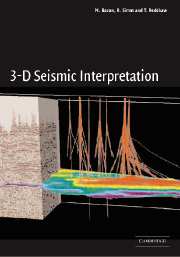Book contents
- Frontmatter
- Contents
- Preface
- 1 Introduction
- 2 3-D seismic data acquisition and processing
- 3 Structural interpretation
- 4 Geological interpretation
- 5 Interpreting seismic amplitudes
- 6 Inversion
- 7 3-D seismic data visualisation
- 8 Time-lapse seismic
- Appendix 1 Workstation issues
- Appendix 2 Glossary
- Appendix 3 Recent developments
- Index
- References
2 - 3-D seismic data acquisition and processing
Published online by Cambridge University Press: 05 March 2013
- Frontmatter
- Contents
- Preface
- 1 Introduction
- 2 3-D seismic data acquisition and processing
- 3 Structural interpretation
- 4 Geological interpretation
- 5 Interpreting seismic amplitudes
- 6 Inversion
- 7 3-D seismic data visualisation
- 8 Time-lapse seismic
- Appendix 1 Workstation issues
- Appendix 2 Glossary
- Appendix 3 Recent developments
- Index
- References
Summary
The aim of seismic data acquisition and processing is to deliver products that mimic cross-sections through the earth. In order to do this, the correct amount and types of data must be acquired, and processing applied to remove unwanted energy (such as multiples), and to place the required events in the correct location. At the same time, a balance needs to be struck between cost and timeliness of data, while attaining also the important objectives of safe operations and doing no harm to the environment.
It is not the aim of this chapter to give a full account of seismic acquisition and processing; rather we aim to concentrate on those aspects that are specific to 3-D operations or are recent innovations. For those who require more information on energy sources, instrumentation, receivers and general acquisition theory there are a number of detailed references such as Stone (1994) and Evans (1997). In addition there are good introductions in some of the more general texts such as Sheriff & Geldart (1995) or McQuillin et al. (1984).
The vast bulk of seismic data currently acquired is 3-D, owing to the tremendous advantages in terms of interpretability discussed in chapter 1. Today it is unusual for the major oil companies to drill exploration wells prior to a 3-D survey being shot, processed and interpreted. Surveys range in size from a few tens of square kilometres for field development to several thousand square kilometres for exploration purposes in frontier basins.
Information
- Type
- Chapter
- Information
- 3-D Seismic Interpretation , pp. 17 - 56Publisher: Cambridge University PressPrint publication year: 2003
